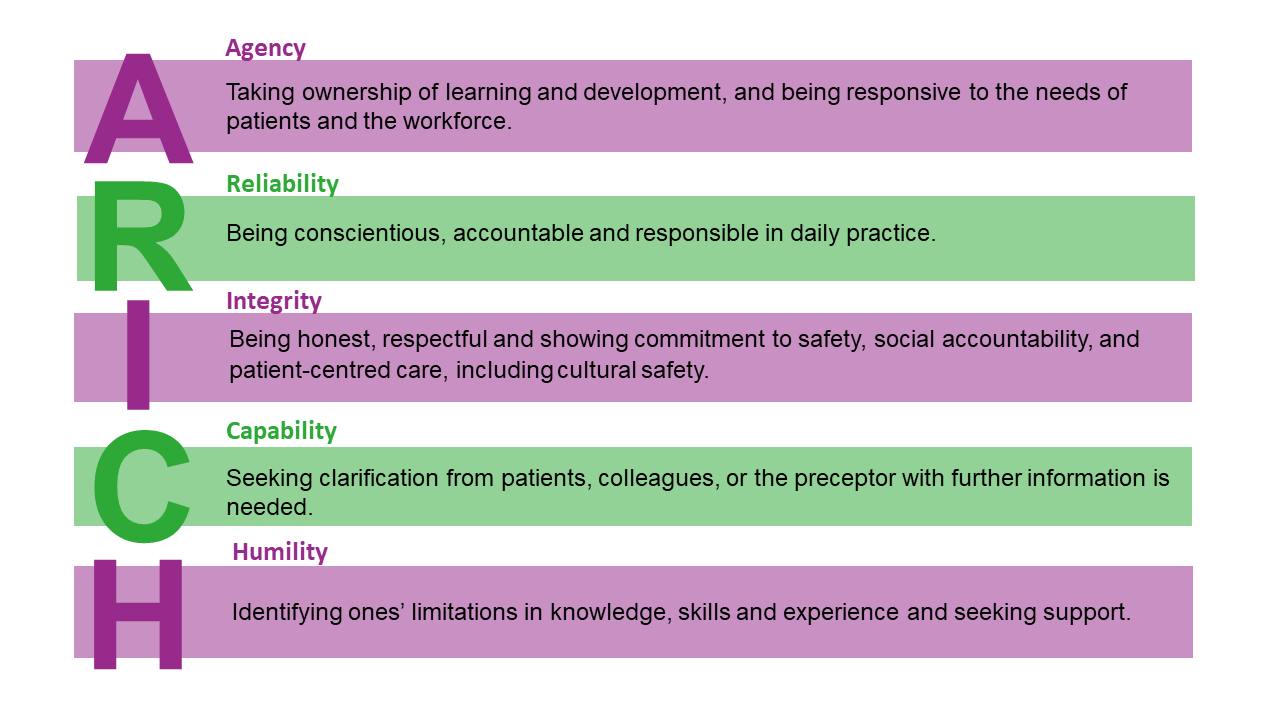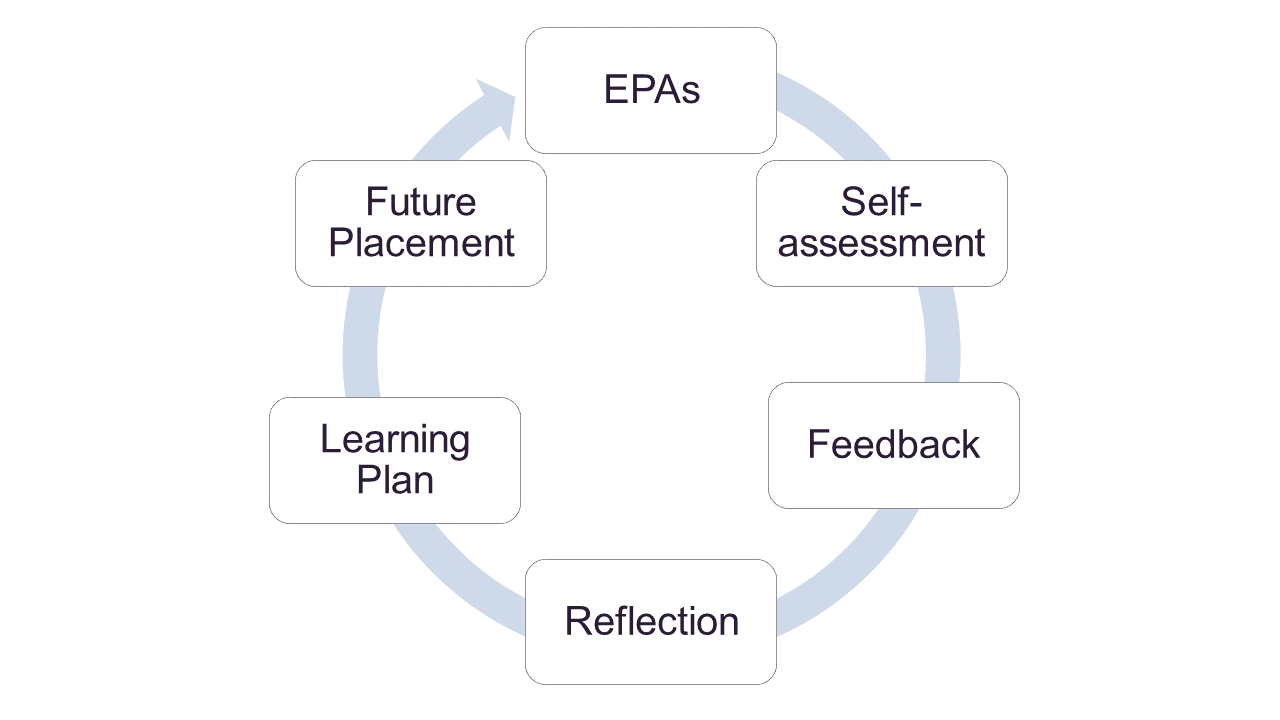4 Entrustable Professional Activities
An Entrustable Professional Activity (EPA) is an observable professional activity, such as a task or responsibility, that can be fully entrusted to a trainee once they have demonstrated the necessary competence to execute the activity unsupervised.
EPAs are used in the Australian Pharmacy Council (APC) internship programs as a work-based assessment; for further information on EPAs, please visit the APC page Introduction to Entrustable Professional Activities. The Bachelor of Pharmacy (Hons) has aligned its workplace activities with this format to prepare students for the work-based assessments they will undertake during their internship program. The EPAs form an integral part of the placements in the Bachelor of Pharmacy (Hons) program have been developed to identify key professional activities relating to patient care or safe healthcare in the workplace, which are aligned to the National Competency Standards Framework and the Australian Pharmacy Council performance outcomes.
Note that the Bachelor of Pharmacy (Hons) EPAs have been scaffolded to an appropriate level for the students and that they differ from EPAs in the internship program.
Entrustable Professional Activities in the Bachelor of Pharmacy (Hons)
There are six skills-based categories of EPAs in the Bachelor of Pharmacy (Hons):
- Prescription fulfilment
- OTC Medicine Management
- Patient education
- Medication history, reconciliation and review
- Non-clinical skills
- Complex clinical skills
Click the plus icons below for more details on each category
The students will complete EPAs from different categories each placement. The infographic below provides an overview of the categories of EPAs that are completed across the program:
Click image to enlarge
Students undertake their first placement in semester 2 in the second year of the program. In this placement, the EPAs focus on foundational skills in prescription fulfilment, and OTC medicine management. In the third year of the program, the EPAs focus on OTC medicine management, medication history, reconciliation and review, and patient education. By the fourth year, the EPAs continue to evaluate skills in OTC medicine management and medication history, reconciliation and review, as well as complex clinical skills and non-clinical skills in data management and teamwork and collaboration.
Within each category, the EPAs have been designed to increase in complexity as the students progress and for students to have the opportunity to apply their skills in a range of professional contexts.
The EPA templates are available on the following pages and are linked within each course page.
Level of Entrustment
The level of entrustment is decided at the end of the placement after observing the student undertake the EPAs. This is represented as a numerical value on a scale of 1-5, however, entrustment level 5 is outside the scope of the Bachelor of Pharmacy (Hons).
It is important to note that an entrustment level is not a grade and does not contribute to the student’s overall course outcomes, but rather, it is intended to help students monitor their progress across their program and identify areas for further development.
A student’s level of entrustment will not always increase from placement to placement, as the complexity of the activity and the work context or level of risk changes. For example, it is expect that a student would receive a lower level of entrustment on a hospital EPA, such as medication chart review, in their third year than they would on a community pharmacy EPA, such as dispensing a prescription, in their second year. Some EPAs, such as provision of OTC medicines, are completed in each placement across the program, therefore, it would be more likely to see an increase in the level of entrustment between placements.
Click the plus icons below for more details on each entrustment level
Qualities that enable entrustment
EPAs have been designed to include qualities that enable entrustment; the APC references the research of ten Cate & Chen (2020), in which the authors propose a model for entrustment decision making using the acronym A RICH: Agency, Reliability, Integrity, Capability, and Humility. For further information on the qualities that enable entrustment, please see the APC page Introduction to Entrustable Professional Activities
These qualities are referred to as Entrustable Attributes in the student self-assessments. Students should be familiar with A RICH and have an awareness that an entrustment level encompasses these attributes. When providing the Entrustment level, we ask that preceptors consider A RICH as well as performance of clinical skills, and provide students with constructive feedback on their self-assessments of the Entrustable Attributes.
Click image to enlarge

Connection to coursework
The EPAs align with our philosophy of student directed learning in the Bachelor of Pharmacy (Hons); students use the EPA templates to seek specific feedback, track their progression across the program, and identify areas for improvement. The EPAs completed during placement are important for the overall course assessment and for future placements, however, the entrustment decisions do not affect a student’s final grade. Students are assessed on their ability to reflect and create a learning plan based on their performance, placement experiences, and feedback.
EPAs |
Reflection |
Learning Plan |
|---|---|---|
|
|
|
Both preceptors and students have an active role in completing the EPAs. For the preceptor, its important to carry out short practice observations during the placement so that the level of entrustment decision is based on multiple observations of the student undertaking these activities at different points in time. Its also important to provide the student with feedback throughout the placement and to help them to consider ways in which they can improve.
The student’s role is to carry out the EPAs responsibly and seek feedback, as well as initiate the final feedback process at the end of the placement by completing a self-assessment in the ePortfolio. When the student submits the self-assessment, the preceptor will receive an email with a link to complete their feedback in the ePortfolio. The student will use this feedback in their reflection and learning plan assessments, where they develop their goals for the next placement.
How to complete an EPA
In the following video, Dr Neil Cottrell and Dr Jane Lee explain the difference in using the EPA templates and how to complete the EPAs with the students:
How to complete the EPAs (YouTube, 3:10m)
The interactive diagram below outlines the recommended placement workflow, showing the activities for the student and the preceptor, for a week long placement.
During the placement, there are multiple short practice observations where the preceptor observes the student completing the EPAs at different points in time during the placement and provides feedback and feed forward.
These short practice observations should also include feedback so that the student has an opportunity to improve during the course of the placement.
Towards the end of the placement, the student will complete their self-assessments of the EPAs in the ePortfolio and submit these electronically to their preceptor. The preceptor will receive an email with a link to view and evaluate the student’s self-assessment.
At the end of the placement, the student and the preceptor meet to discuss the student’s self-assessments, final feedback, and discuss some potential goals for the next placement.
This sequence of activities applies equally to the longer 6 week placements.
Slide the bar on the image below to see a comparison of preceptor and student activities.
Instructions for how to use the ePortfolio are provided in Chapter XXX
Constructive comments on past performance
Recommendations or advice to improve future performance



